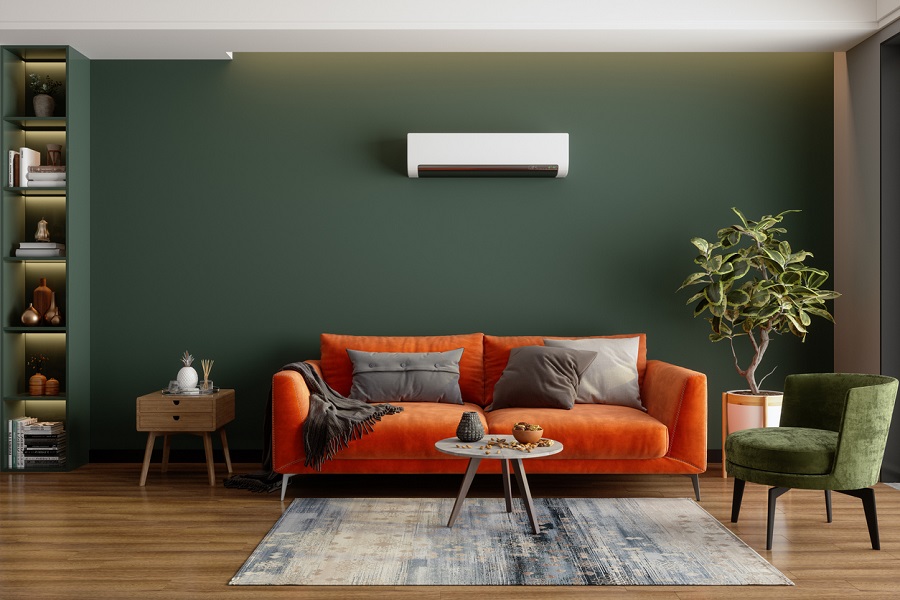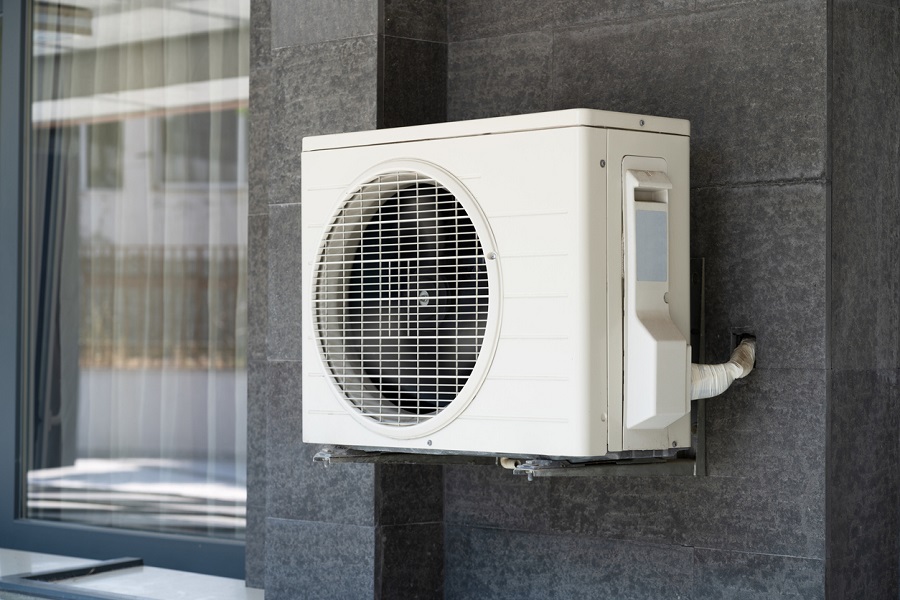What is a Mini Split Air Conditioner? Everything You Need to Know in 2022
There are many different types of air conditioning systems on the market, so which is the right fit for your home? Today we will discuss the mini-split system and its benefits and drawbacks to help you select the right system.
What is a mini split air conditioning system
A mini split AC system is an AC system that is designed to control temperatures in individual rooms or small spaces. The mini split comprises two main components-an outdoor compressor/condenser and an indoor evaporator. A conduit that houses power cables, refrigerant tubing, suction tubing, and a condensate drain links the outdoor and indoor units.
There are four types of mini-splits: single-zone, pre-charged single zone, hyper heat single-zone, and multi-zone.
The components of a mini-split system
A mini-split AC system comprises these components:
- Outdoor compressor
- Compressor-Pressurizes refrigerant gas, converting it from a gas into a liquid. It also pumps liquid through refrigerant lines that run into the indoor unit
- Condenser coils-Condenser coils release heat into the outside air, which is compressed into hot refrigerant vapor, which circulates into the coils and condenses into a liquid state.
- Outdoor Fan-The fan blows over the condenser coils, cooling them down
- Expansion valve- The valve allows high-pressure liquid refrigerant to expand immediately, cooling it down before entering the evaporator unit.
- Indoor Evaporator
- Evaporator coil-Cold refrigerant flows into the coil, absorbing heat, causing the refrigerant to evaporate into a gas and carry heat outwards
- Blower-The blower draws in warm air and blows cool air back into the room
- Air filter-Cool air goes through the air filter which catches any contaminants and allergens before they are circulated to you, improving the indoor air quality.
Central air versus mini-split system
Central air uses a pre-existing duct system to provide cooling to a large area. Mini-split units are smaller units that don’t require any pre-existing system to provide cooling to an area. They control temperature, but central air has to regulate it in a large area, like a multi-room house, making it less efficient when regulating a particular area such as a single bedroom.
In general, mini-splits are more efficient, flexible, and can be installed anywhere. However, they provide worse filtration and poor drainage as their fans are not very powerful. They also require more frequent maintenance due to their size. Central air systems can cover a wider area, have a lower initial cost than a mini-split, and can increase your property value.
The tradeoff is that you will pay a hefty utility bill every month, your ductwork will require maintenance, and temperature control for individual rooms is less efficient than a mini-split system.
The benefits of the mini split air conditioning system
Mini-split air conditioning provides a few benefits to your home, mainly better temperature controls. Their size also provides a greater deal of flexibility for installation, especially when you don’t have a large home to cool.
More efficient temperature control
Compared to central air, a mini-split is much more efficient at controlling temperatures in a singular area. So if your space is small, a mini-split is the best choice.
Built-in zoning
The size of a mini-split allows for the creation of different zones in your home, allowing for differentiating temperatures as opposed to central air that only has one uniform temperature.
Does not require existing ductwork
A mini-split’s design means that it doesn’t need existing ductwork to operate as opposed to central air that requires ductwork to function, which can take up a large amount of space.
Flexible install
A mini-split’s smaller size allows it to be installed in any home, regardless of size.
The disadvantages of the mini split air conditioning system
While a mini-split offers your home many great benefits, it also comes with a few negatives as well. The primary disadvantage is that its fans are less powerful due to their small size, its fans are less powerful, making it more difficult when it comes to temperature control in a large space.
Poor filtration
With a weaker fan, a mini-split has worse filtration when compared to a central air unit.
More maintenance
Mini-splits are much smaller units and need their filters cleaned once a month. Its important that an AC system receives regular maintenance.
Poor aesthetic
A mini-split unit cannot be hidden, so it will just appear in your household, which can clash with your aesthetic.
Costly initial price
A mini-split is much more expensive upfront than a central air system.
How does mini split air conditioning system work
Mini-split AC units can be complicated systems to understand. Here is how the system functions and how you get cold air in your home:
- A compressed refrigerant in liquid form flows from the outdoor unit to the indoor unit through refrigeration lines
- When liquid refrigerant arrives in the evaporator coils, it expands and turns from liquid to gas.
- The indoor air blower sucks in warm indoor air and pushes it to cold coils, cooling the air and removing the humidity. This cool, dry air is circulated through the house and is what we experience as cool air
- The gaseous refrigerant now travels back to the outdoor unit
- Refrigerant is compressed in the outdoor unit and turned back into a liquid, removing the heat.
- Once the refrigerant is liquid again, it travels back into the indoor unit
- The cycle begins again
Single versus multi-zone configurations
Multi-split units can be configured in one of two ways: single or multi-zone. A single zone provides one condenser and one handler, allowing you to cool and heat one room. A multi-zone connects the condenser to multiple handlers, allowing control over multiple rooms.
Ideal setup for mini-split configuration
- Small rooms; Garage, apartments, sunrooms-Small rooms can utilize a mini-split perfectly as it won’t steal air from other rooms or overload your existing system
- Downsizing for larger home-You can reduce your utility bill by incorporating more mini-split units to add individual temperature controls and reducing the usage of a central air system.
- Serving multiple needs under one roof-Central air is great for providing temperature control to a large space, but individuals have different needs. A mini-split allows for individual temperature changes, so everyone is happy.
- Adding AC to a home without ductwork-A mini-split provides AC temperature control without the need for existing ductwork to be set up.
Mini-split system modes
Mini-split systems provide the following modes:
Auto-Automatically shifts between both cool and heat modes depending on the temperature
Dry-Reduces the humidity that the device produces, works similar to cool, but regulates temperature differently
Cool-Cool reduces the temperature when it reaches a high point and continually produces cool air until the target temperature is reached.
Heat-Heat increases the temperature if it reaches the target temperature, producing hot air until the target temperature is reached.
The average cost of a mini-split system
A mini-split system can be very expensive for the unit and the installation. Here is how much a mini-split will cost:
The outdoor condenser will cost anywhere from $1,000-7,000. The indoor wall-mounted unit will cost anywhere from $400-1,000, and the ceiling-mounted unit will run $700-2,000. The refrigerant line is around $5-6 per foot. An accessory kit will run $300-500. Labor costs will run anywhere from $300-1500 and can be installed within 10 hours. Finally, you will need a permit to install a mini-split system, especially if it’s multi-zoned which will cost you another $200-400. On average, you are looking at around $5000-8000 per zone, and with multi-zoned units, expect to pay around 15-20,000 or more.
Is it hard to install?
Yes, a multi-split unit is difficult to install and should only be handled by a professional.
How to determine the size of your needed mini-split system/factors to consider
To determine the size of your mini-split, you need to obtain the size of your space:
Square feet: Multiply the length by width
Triangular space: Multiply the length by width then divide by two
Circular: Measure the largest width of the room (diameter), divide by two, square it, the multiply the result by pi.
Non-standard linear: Divide the room into squares, rectangles or triangles. Determine the size of each divided area then add them together.
You will also need to factor in ceiling height, sunlight, room type, capacity, insulation, and location.
Ceiling height: increase your BTU total by 25% if higher than 10 feet.
Sunlight: More sunlight, increase BTU by 10%, Less sunlight reduce BTU by 10%
Room type-Kitchen, add 4,000 BTU and add 20%
Capacity-add 600 BTU per individual in the space
Insulation-Poor insulation requires 20% BTU loss
BTUs provide a rough estimation of the space required and the amount of heating or cooling a space needs to reach the temperature.
| Space in square feet | BTUs per hour needed |
| 0-150 | 5000 |
| 150-250 | 6000 |
| 250-300 | 7000 |
| 300-350 | 8000 |
| 700-1000 | 18,000 |
| 1200-1400 | 23,000 |
| 1400-1500 | 24,000 |
| 1500-2,000 | 30,000 |
| 2,000-2500 | 34,000 |
Popular Brands
When it comes to choosing your multi-split unit, there are many noteworthy brands to choose from. Here are the most popular brands on the market today:
- Mitsubishi
- Daikin
- Greer
- Carrier
- Mr Cool
- Klimaire
- Toshiba
- Fujistu
- LG
Mini-split systems provide a whole host of benefits to any home, namely precision temperature control and reduced utility bills. However, that benefit comes with some steep initial price tags, so consider that carefully before purchasing one for your home.



